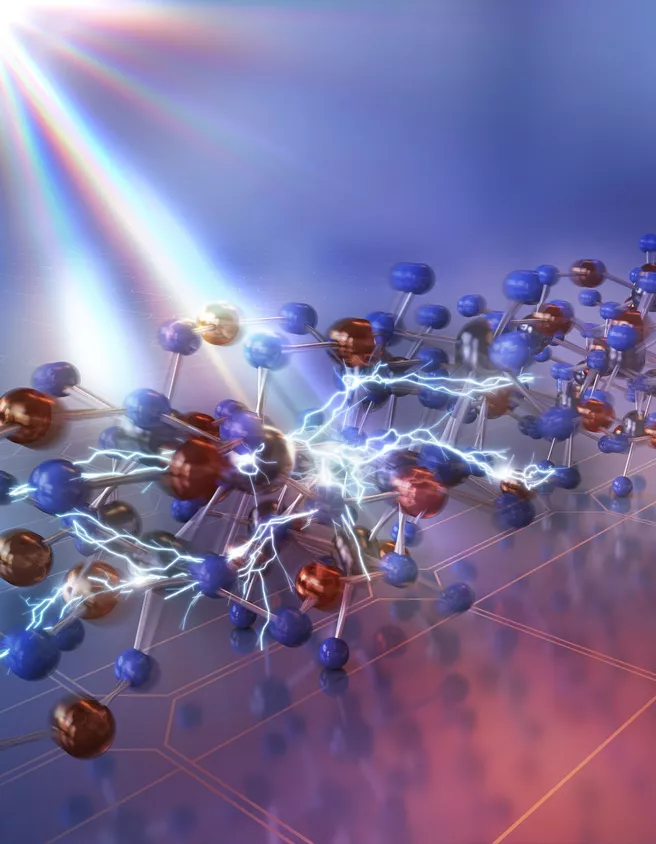Blues, Rock'n roll, Charleston. When three teams dance to different rhythms simultaneously, hardly anything good can occur – or so you would think. However, groups of atoms "swinging" together in the crystal lattice can actually have very positive effects. This is what scientists at the Technical University of Munich discovered when they took a closer look at a promising material for the energy transition: the semiconductor copper tantalum nitride (CuTaN2). "We knew from literature that the compound absorbs visible light very well and can transport electrical charges. Through our investigations, we can now show the exact reasons for this– at an atomic level," says postdoctoral researcher Dr. Franziska Hegner, who works in Prof. David Egger's and Professor Ian Sharp’s teams at the Department of Physics and the Walter-Schottky Institute. The group’s research is funded by the e-conversion Cluster of Excellence, among others.
Atoms in the optimal lattice choreography
The chemist decoded the exact dance rhythms of the individual atom groups, so to speak, and recently published the results in the journal Advanced Energy Materials. She carried out density functional theory and molecular dynamics calculations and examined the semiconductor material using special vibrational spectroscopy (Raman measurements). Hegner carried out the latter at the Weizman Institute of Science in Israel in the group of Prof. Omer Yaffe because the low-frequency vibrations of the atoms, in particular, can be analyzed there. The researcher discovered that primarily anharmonic vibrations determine the structure and, thus, the property profile of the semiconductor. What surprised Hegner most of all: "You might assume that various irregular vibrations make the CuTaN2 crystal lattice more unstable, but the opposite is the case," says the chemist. The atoms' unique choreography is also why copper tantalum nitride does not correspond exactly to the symmetrical delafossite structure described in the literature. "Our investigations show that this crystal lattice is unstable even at room temperature due to the atomic dynamics. That alone is a special feature," she explains. The delafossite structure is therefore distorted – which, in turn, impacts the material properties. The fact that this interaction exists is one of the key findings of the research work.
Reaching the goal with synthesis tricks
The TUM research team was actively supported by scientists from the Ludwig Maximilian University of Munich: Dr. Stefan Rudel, a postdoctoral researcher in Prof. Wolfgang Schnick's working group, which specializes in the synthesis of nitrides, produced the CuTaN2. The production process is sophisticated and is based on a synthesis specification from the 1990s. Rudel also modified individual steps to obtain a very pure product. Tantalum's love of oxygen particularly challenged the chemist. He could not use the vessels commonly used for similar solid-state reactions, known as corundum boats, where the starting substances are placed. The reason is that the sodium tantalum nitride required for the synthesis is produced under harsh reaction conditions, in which the oxygen atoms are removed even from this very stable aluminum oxide vessel. Rudel, therefore, placed the reactants – sodium and tantalum nitride – in a copper tube instead. Only then pure copper tantalum nitride can be formed in the subsequent ion exchange reaction with copper iodide. During the reaction, which takes place at more than 400 degrees Celsius, the copper ions migrate into the structure and displace the sodium. The resulting CuTaN2 is a brownish-black powder composed of 200 nanometer small, trapezoidal crystals.
Future potential: customized nitride semiconductors
X-ray diffraction and electron micrographs confirmed that the researchers had successfully produced the semiconductor material. "It was very fortunate for us that we became aware of the LMU team through the cooperation within the e-conversion cluster and were thus able to use the copper tantalum nitride in this pure form," says TUM chemist Hegner. "This was the only way we could conduct meaningful investigations and determine the great influence that atomic dynamics have on semiconductor properties and, above all, on light absorption." At the same time, the research teams point out further possibilities in their paper. "We also obtain important information on how we can tailor CuTaN2 and similar chemical compounds for applications that convert light into electrical energy," summarizes Egger.
Publication:
The Critical Role of Anharmonic Lattice Dynamics for Macroscopic Properties of the Visible Light Absorbing Nitride Semiconductor CuTaN2, Adv. Energy Mat.
F. Hegner, A. Cohen, S. Rudel, S. Kronawitter, M. Grumet, X. Zhu, R. Korobko, L. Houben, C. Jiang, W. Schnick, G. Kieslich, O. Yaffe, I. Sharp, D. Egger
https://doi.org/10.1002/aenm.202303059
Contact:
Dr. Franziska Hegner
Technical University of Munich
Physics Department
Prof. Dr. David Egger
Technical University of Munich
Physics Department
Website: https://theofem.de/
